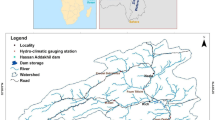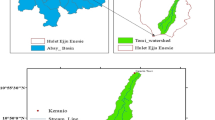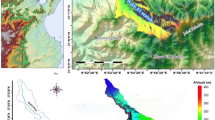Abstract
Erosion hazard is a major environmental change in developing countries and therefore necessitates investigations for effective erosion control measures. This study is hinged on the numerous advantages of a hybrid Multi-Criteria Decision Model (MCDM) to assess erosion vulnerability using remote-sensed data and the application of Geographical Information System (GIS). Nine risk factors of erosion were selected for this study and their thematic maps were utilized to produce a spatial distribution of erosion hazard in the state. An integrated IVFRN–DEMATEL–ANP model was used to investigate the interrelationships between the risk factors and also obtain their final weights. The assessment model identified Rainfall, Erosivity Index, Stream Power Index, Sediment Transport Index, Topographic Wetness Index, and Soil as the most influential factors of erosion in the study area. The weighted linear combination method was used to integrate the risk factors to produce the spatial distribution of erosion vulnerability model. The method was validated using Anambra State of Nigeria. The findings from the study revealed that Anambra State is vulnerable to erosion hazard with 45% of the state lying between Very High and Medium vulnerable zones. A good predictive model performance of 89.7% was obtained using the AUC-ROC method. The feasibility of integrating the IVFRN, DEMATEL, and ANP models as an assessment model for mapping erosion vulnerability has been determined in this study, and this is vital in managing the impact of erosion hazards globally. The model’s identification of hydrological and topographical factors as major causes of erosion hazard emphasizes the importance of critical analysis of risk factors as done in this study for effective management of erosion. This study is a veritable tool for implementation of erosion mitigation measures.







Similar content being viewed by others
Data availability
Data will be made available on request.
Code availability
This does not apply to this manuscript.
References
Ahmad SNNB, Mustafa FB, Yusoff YM, Didams G (2020) A systematic review of soil erosion control practices on the agricultural land in Asia. Int Soil Water Conserv Res 8:103–115. https://doi.org/10.1016/j.iswcr.2020.04.001
Ajibade FO, Nwogwu NA, Adelodun B, Abdulkadir TS, Ajibade F, Lasisi KH, Fadugba OG, Owolabi TA, Olajire OO (2020) Application of RUSLE integrated with GIS and remote sensing techniques to assess soil erosion in Anambra state, south-eastern Nigeria. J Water Clim Change 11(1):407–422. https://doi.org/10.2166/wcc.2020.222
Andualem TG, Hagos YG, Kefale A, Zelalem B (2020) Soil erosion prone area identification using multi-criteria decision analysis in Ethiopian highlands. Model Earth Syst Environ 6(3):1407–1418. https://doi.org/10.1007/s40808-020-00757-2
Arabameri A, Pradhan B, Rezaei K, Conoscenti C (2019) Gully erosion susceptibility mapping using GIS-based multi-criteria decision analysis techniques. CATENA 180:282–297. https://doi.org/10.1016/j.catena.2019.04.032
Aslam B, Maqsoom A, Salah W, Ali M, Jabbar T, Zafar A (2021) Soil erosion susceptibility mapping using a GIS-based multi-criteria decision approach: case of district Chitral, Pakistan. Ain Shams Eng J 12(2):1637–1649. https://doi.org/10.1016/j.asej.2020.09.015
Bashir IY, Sallau RO, Sheikh AD, Aminu Z, Hassan SM (2020) GIS-based MCDA for gully vulnerability mapping using AHP techniques. J Geogr Stud 4(2):45–63. https://doi.org/10.21523/gcj5.20040201
Borrelli P, Alewell C, Alvarez P, Alexandre J, Anache A, Baartman J, Ballabio C, Bezak N, Biddoccu M, Cerdà A, Chalise D, Chen S, Chen W, Maria A, Girolamo D, Desta G, Deumlich D, Diodato N, Efthimiou N, Panagos P (2021) Soil erosion modelling: a global review and statistical analysis. Sci Total Environ 780:146494. https://doi.org/10.1016/j.scitotenv.2021.146494
Chalise D, Kumar L, Kristiansen P (2019) Land degradation by soil erosion in Nepal: a review. Soil Syst 3(12):1–18. https://doi.org/10.3390/soilsystems3010012
Chibuzor SN, Okoyeh EI, Egboka BCE, Onwuemesi AG (2020) Gullying processes in the upper Idemili river catchment area of Anambra state, Nigeria. Asian J Geol Res 3(4):64–78
Das B, Bordoloi R, Thungon LT, Paul A, Pandey PK, Mishra M, Tripathi OP (2020) An integrated approach of GIS, RUSLE And AHP to model soil erosion in west kameng watershed, Arunachal Pradesh. J Earth Syst Sci 129(94):1–18. https://doi.org/10.1007/s12040-020-1356-6
Dike BU, Agunwamba JC, Alakwem OP (2015) GIS-based multi-criteria evaluation (MCE) approach for assessment of Urualla gully erosion watershed. Proceedings of the Institute of Erosion Studies (IES) 2
Eekhout JPC, Vente JD (2022) Global impact of climate change on soil erosion and potential for adaptation through soil conservation. Earth Sci Rev 226:103921. https://doi.org/10.1016/j.earscirev.2022.103921
Egboka BCE, Orji AE, Nwankwoala HO (2019) Gully erosion and landslides in southeastern Nigeria: causes, consequences and control measures. Glob J Eng Sci 2(4):1–11. https://doi.org/10.33552/GJES.2019.02.000541
Egwuonwu GN, Okoyeh EI, Chikwelu EE (2019) 2DNear-surface litho-structural geophysical investigation at the vicinities of two gully-erosion/landslide sites in south-eastern Nigeria. IOSR J Appl Geol Geophys 7(5):70–75. https://doi.org/10.9790/0990-0705017075
Enekwechi EE (2017) Effects of pollution and contamination of water bodies: a case of Anambra state. Afr J Educ Sci Technol 3(4):41–47
Fagbohun BJ, Olabode OF, Olufemi A, Akinluyi FO (2017) GIS-based sub-basin scale identification of dominant runoff processes for soil and water management in Anambra area of Nigeria. Contemp Trends Geosci 6(2):80–93. https://doi.org/10.1515/ctg-2017-0007
Guo Y, Peng C, Zhu Q, Wang M, Wang H, Peng S (2019) Modelling the impacts of climate and land use changes on soil water erosion: model applications, limitations and future challenges. J Environ Manag 250:109403. https://doi.org/10.1016/j.jenvman.2019.109403
Guo L, Liu R, Men C, Wang Q, Miao Y, Shoaib M, Wang Y, Jiao L, Zhang Y (2021) Multiscale spatiotemporal characteristics of landscape patterns, hotspots, and influencing factors for soil erosion. Sci Total Environ 779:146474. https://doi.org/10.1016/j.scitotenv.2021.146474
Haidara I, Tahri M, Maanan M, Hakdaoui M (2019) Efficiency of fuzzy analytic hierarchy process to detect soil erosion vulnerability. Geoderma 354:113853. https://doi.org/10.1016/j.geoderma.2019.07.011
Halefom A, Teshome A, Sisay E, Dananto M (2018) Erosion sensitivity mapping using GIS and multi-criteria decision approach in ribb watershed upper blue nile, Ethiopia. Int J Energy Environ Sci 3(6):99–111. https://doi.org/10.11648/j.ijees.20180306.11
Hatefi SM, Tamošaitienė J (2019) An integrated fuzzy DEMATEL-ANP model for evaluating construction projects by considering interrelationships among risk factors. J Civ Eng Manag 25(2):114–131
Hategekimana Y, Yu L, Nie Y, Zhu J, Liu F, Guo F (2018) Integration of multi-parametric fuzzy analytic hierarchy process and GIS along the UNESCO world heritage: a flood hazard index, Mombasa County, Kenya. Nat Hazards 92(2):1137–1153. https://doi.org/10.1007/s11069-018-3244-9
Igwe PU, Ezeukwu JC, Edoka NE, Ejie OC, Ifi GI (2017) A review of vegetation cover as a natural factor to soil erosion. Int J Rural Dev Environ Health Res 1(4):21–28. https://doi.org/10.22161/ijreh.1.4.4
Iliyasu AM, Buba YA, Timnan N, Emeson S, Oyekeshi N (2019) Environmental effects of gully erosion in nigeria case study of Nanka community, Orumba north LGA of Anambra state. J Environ Earth Sci 9(10):68–82. https://doi.org/10.7176/JEES/9-10-08
Isife TC (2019) Environmental challenges and protection practices among women of anaocha LGA of Anambra state, Nigeria. Afr J Sustain Dev 7(3):137–149
Jin F, Yang W, Fu J, Li Z (2021) Effects of vegetation and climate on the changes of soil erosion in the loess plateau of China. Sci Total Environ 773:145514. https://doi.org/10.1016/j.scitotenv.2021.145514
Kadoic N, Divjak B, Redep NB (2019) Integrating the DEMATEL with the analytic network process for effective decision-making. CEJOR 7(3):653–678. https://doi.org/10.1007/s10100-018-0601-4
Kanani-Sadat Y, Arabsheibani R, Karimipour F, Nasseri M (2019) A new approach to flood susceptibility assessment in data-scarce and ungauged regions based on GIS-based hybrid multi criteria decision-making method. J Hydrol 572:17–31. https://doi.org/10.1016/j.jhydrol.2019.02.034
Mezie EO, Nwajuaku AI (2020) Investigation into the causes of gully erosion in parts of Anambra state. J Sci Technol Res 2(1):139–149
Mosavi A, Sajedi-Hosseini F, Choubin B, Taromideh F, Rahi G, Dineva AA (2020) Susceptibility mapping of soil water erosion using machine learning models. Water 12(7):1995. https://doi.org/10.3390/w12071995
Mosavi A, Golshanc M, Janizadehd S, Choubine B, Dineva AA, Melesse AM (2022) Ensemble models of GLM, FDA, MARS, and RF for flood and erosion susceptibility mapping: a priority assessment of sub-basins. Geocarto Int 37(9):2541–2560
Mushi CA, Ndomba PM, Trigg MA, Tshimanga RM, Mtalo F (2019) Assessment of basin-scale soil erosion within the congo river basin: a review. CATENA 178:64–76. https://doi.org/10.1016/j.catena.2019.02.030
Nwobodo CE, Otunwa S, Ohagwu VA, Enibe DO (2018) Farmers use of erosion control measures in Anambra state, Nigeria. J Agric Ext 22(3):174–184. https://doi.org/10.4314/jae.v22i3.17
Obioji JN, Eze KT (2019) Disaster management in Nigeria: a study of Anambra State, 2011–2019. Int J Innov Dev Policy Stud 7(4):83–103
Odunuga S, Ajijola A, Igwetu N, Adegun O (2018) Land susceptibility to soil erosion in orashi catchment, Nnewi south, Anambra state, Nigeria. Proc IAHS 376:87–95. https://doi.org/10.5194/piahs-376-87-2018
Ogbonnaya I, Ugwuoke IJ, Onwuka S, Ozioko O (2020) GIS-based gully erosion susceptibility modeling, adapting bivariate statistical method and AHP approach in Gombe town and environs northeast Nigeria. Geoenviron Disasters 7(32):1–16. https://doi.org/10.1186/s40677-020-00166-8
Okonufua E, Olajire OO, Ojeh VN (2019) Flood vulnerability assessment of afikpo south LGA, Ebonyi state, Nigeria. Int J Environ Clim Change 9(6):331–342. https://doi.org/10.9734/IJECC/2019/v9i630118
Okoyeh EI, Akpan AE, Egboka BCE, Okeke HI (2014) An assessment of the influences of surface and subsurface water level dynamics in the development of gullies in Anambra state, southeastern Nigeria. Earth Interact 18(4):1–24. https://doi.org/10.1175/2012EI000488.1
Pamucar D, Mihajlovic M, Obradovic R, Atanaskovic P (2017) Novel approach to group multi-criteria decision making based on interval rough numbers: hybrid DEMATEL-ANP-MAIRCA model. Expert Syst Appl 88:58–80. https://doi.org/10.1016/j.eswa.2017.06.037
Pamučar D, Petrović I, Ćirović G (2018) Modification of the best–worst and MABAC methods: a novel approach based on interval-valued fuzzy-rough numbers. Expert Syst Appl 91:89–106. https://doi.org/10.1016/j.eswa.2017.08.042
Pamučar D, Ćirović G, Božanić D (2019) Application of interval valued fuzzy-rough numbers in multi-criteria decision making: the IVFRN-MAIRCA model. Yugosl J Oper Res 29(2):221–247. https://doi.org/10.2298/YJOR180415011P
Peng Q, Wang R, Jiang Y, Zhang W, Liu C (2022) Soil erosion in Qilian mountain national park: dynamics and driving mechanisms. J Hydrol Reg Stud 42:101144. https://doi.org/10.1016/j.ejrh.2022.101144
Rahman RM, Shi ZH, Chongfa C, Dun Z (2015) Assessing soil erosion hazard- a raster based GIS approach with spatial principal component analysis (SPCA). Earth Sci Inf 8(4):853–865. https://doi.org/10.1007/s12145-015-0219-1
Roy J, Pamučar D, Kar S (2020) Evaluation and selection of third party logistics provider under sustainability perspectives: an interval valued fuzzy-rough approach. Ann Oper Res 293(2):669–714. https://doi.org/10.1007/s10479-019-03501-x
Saha S, Gayen A, Pourghasemi HR, Tiefenbacher JP (2019) Identification of soil erosion susceptible areas using fuzzy logic and analytical hierarchy process modeling in an agricultural watershed of Burdwan district, India. Environ Earth Sci 78(23):1–18. https://doi.org/10.1007/s12665-019-8658-5
Saini SS, Jangra R, Kaushik SP (2015) Vulnerability assessment of soil erosion using geospatial techniques- a pilot study of upper catchment of Markanda river. Int J Adv Remote Sens GIS Geogr 3(1):9–21
Sajedi-Hosseini F, Choubin B, Solaimani K, Cerdà A, Kavian A (2018) Spatial prediction of soil erosion susceptibility using FANP: application of the fuzzy DEMATEL approach. Land Degrad Dev 29(9):3092–3103. https://doi.org/10.1002/ldr.3058
Song W, Zhu Y, Zhao Q (2020) Analyzing barriers for adopting sustainable online consumption: a rough hierarchical DEMATEL method. Comput Ind Eng 140(37):106279. https://doi.org/10.1016/j.cie.2020.106279
Tamene L, Le QB (2015) Estimating soil erosion in sub-Saharan Africa based on landscape similarity mapping and using the revised universal soil loss equation (RUSLE). Nutr Cycl Agroecosyst 102(1):17–31. https://doi.org/10.1007/s10705-015-9674-9
Wang Y, Hong H, Chen W, Li S, Pamucar D, Gigovic L, Drobnjak S, Bui DT, Duan H (2019) A hybrid GIS multi-criteria decision-making method for flood susceptibility mapping at Shangyou, China. Remote Sens 11(1):62. https://doi.org/10.3390/rs11010062
Xiong M, Sun R, Chen L (2019) A global comparison of soil erosion associated with land use and climate type. Geoderma 343:31–39. https://doi.org/10.1016/j.geoderma.2019.02.013
Funding
This research did not receive any specific grant from funding agencies in the public, commercial, or not-for-profit sectors.
Author information
Authors and Affiliations
Contributions
This work was carried out in collaboration between all the authors. ECC and CCO designed the study, CCO carried out the field survey and collected the data, and CCO and ECC analyzed the data, and wrote the protocol. LCO and GCO wrote the first draft of the manuscript, and edited the manuscript.
Corresponding author
Ethics declarations
Conflict of interest
The authors declare that they have no known competing financial interests or personal relationships that could have appeared to influence the work reported in this paper.
Additional information
Publisher's Note
Springer Nature remains neutral with regard to jurisdictional claims in published maps and institutional affiliations.
Rights and permissions
Springer Nature or its licensor holds exclusive rights to this article under a publishing agreement with the author(s) or other rightsholder(s); author self-archiving of the accepted manuscript version of this article is solely governed by the terms of such publishing agreement and applicable law.
About this article
Cite this article
Okonkwo, C.C., Chukwuma, E.C., Orakwe, L.C. et al. Geospatial-based analysis for soil erosion susceptibility evaluation: application of a hybrid decision model. Model. Earth Syst. Environ. 9, 987–1007 (2023). https://doi.org/10.1007/s40808-022-01527-y
Received:
Accepted:
Published:
Issue Date:
DOI: https://doi.org/10.1007/s40808-022-01527-y




